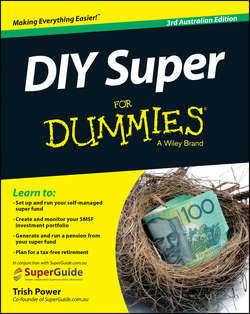Читать книгу DIY Super For Dummies - Power Trish, Trish Power - Страница 14
Part I
Taking Control of Your Super
Chapter 2
Understanding How Super Works
Appreciating a Super Fund’s DNA
ОглавлениеTrying to describe what makes up a superannuation fund is a bit like describing the body of a human being: I know one when I see one. What you do need to understand is that a super fund has key elements that make it very different from a bank account, or a managed fund, where the money of many investors is pooled into one investment vehicle (for more information about managed funds, see Chapter 14).
A superannuation fund is very similar to the human body – really. Without being risque, picture the human body for a moment. Your mental image of the body may have dark skin, and a head with brown hair and blue eyes. Or, the body may be very tall with a head that has no hair. Or perhaps an image of a Hollywood actor, such as Cate Blanchett, Hugh Jackman or Nicole Kidman, pops into your head?
Irrespective of what type of body you pictured, under all the clothes, your human body is the same as everyone else’s. Each body normally has a head, two arms, two eyes and a torso. The shape and size may differ, but you know what a human body looks like and what identifying features allow you to know it is a body.
Just like the human body, your superannuation fund also has key distinguishing features that identify it as a super fund.
Here are six traits that, if present, are a certain giveaway that you’re looking at a super fund:
✔ An obvious name: The word ‘superannuation’ or ‘super’ appears in the fund’s name.
✔ Trustee: A ‘trustee’ or ‘trustee board’ runs the fund (I explain the role of the trustee in Chapters 7, 8 and 9). The only superannuation vehicle that doesn’t have a trustee is a Retirement Savings Account (RSA). For more information about this type of account, see the section ‘Discovering seven fund types on your super safari’ later in this chapter. I explain different types of super funds in the next section.
✔ Governing rules: A ‘trust deed’ (or, for a public sector fund, the governing rules in the form of an Act of Parliament) sets out the rules for running the fund. (I explain the importance of a trust deed in Chapter 7.)
✔ Regulated fund: The trustees ‘elect’ the Superannuation Industry (Supervision) Act 1993 (SIS Act) – the statutory bible for all superannuation funds – to regulate the fund. (I explain the SIS Act in Chapters 9 and 11, later in this book.)
✔ Complying fund: The fund has complying fund status; that is, the fund has followed all the rules set out in the SIS Act, including complying with the fund’s trust deed.
✔ APRA licence or operates as a SMSF: If the super fund is not a self-managed super fund (SMSF), then the trustee must have an RSE licence from the Australian Prudential Regulation Authority (APRA) and the fund must be registered. RSE stands for ‘registrable superannuation entity’. (For information about APRA and RSE licences, refer to Chapter 1.) If you run a SMSF, your fund does not need an APRA licence, although you and the other trustees will need to be vetted by the Australian Tax Office (ATO). For details about ATO requirements, see Chapter 7.
Two key elements separate super funds from the thousands of managed funds that exist out there in the financial wild:
✔ The requirement that a super fund makes an election for regulation by the SIS Act.
✔ A super fund’s complying fund status.
These two features make your super fund eligible to receive tax concessions (for info about these tax breaks, see Chapter 13), and to receive your employer’s compulsory contributions and your own contributions (I discuss these contributions in more detail in Chapter 4).
If you haven’t actively chosen your super fund, since 1 January 2014, your employer’s compulsory SG contributions have been paid into a MySuper product chosen by your employer. A MySuper product is a super fund that has a single diversified investment option and simple features, which are designed to make it easier to compare super funds. I explain the role of a MySuper fund in the section ‘Discovering seven fund types on your super safari’ later in this chapter.
Only complying superannuation funds can receive superannuation contributions and get concessional taxation treatment; that is, pay lower tax rates. If you break the super rules, your SMSF could be deemed to be ‘non-complying’ and you potentially lose up to half of your fund assets. The stronger likelihood, however, is that if your SMSF breaks the super rules, your SMSF, or you as SMSF trustee, will be hit with financial penalties (covered in Chapters 9 and 11). Having complying fund status, however, doesn’t guarantee that your fund is going to deliver positive returns.
If you want to know whether your current fund – or another fund that you’re considering joining – is a complying fund, you can check a list. The government’s Super Fund Lookup website (http://superfundlookup.gov.au) is a publicly available list of all complying superannuation funds in Australia (that is, SMSFs and super funds regulated by APRA). If you decide to set up your own super fund, your SMSF will also join this list. You can then type in your super fund’s name to check that your fund is complying. If your SMSF has not yet lodged its first annual return (for info on doing so, see Chapter 12), your SMSF will be described as ‘Registered – status not determined’ on Super Fund Lookup. This means that the SMSF can still accept super contributions and transfers from other super funds.
